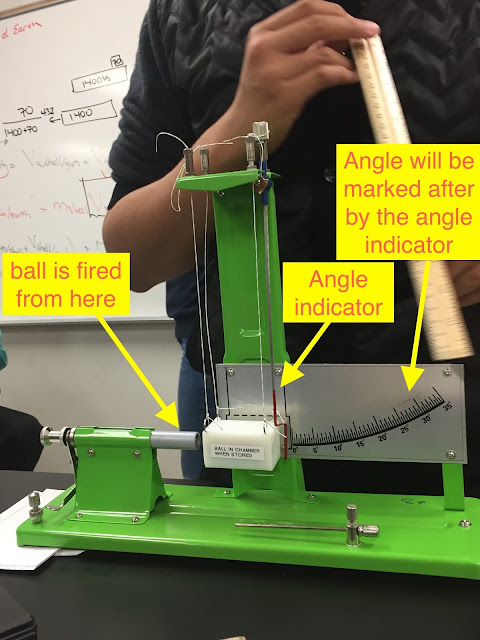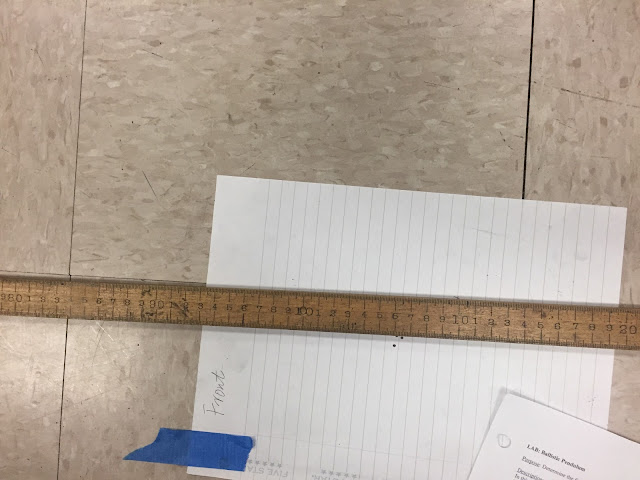Lab 17: Finding the Moment of Inertia of a Uniform Triangle about its Center of Mass
May Soe Moe
Lab partners: Ben Chen, Stephanie Flores, Steven Castro
Date: 22-May-2017
Objective: To determine the moment of inertia of a uniform triangle about its center of mass through experiment and compare the experimental and theoretical values
Introduction:
To determine the moment of inertia of a uniform triangle, we will orient the triangle into two perpendicular orientations in this lab. We will determine they moment of inertia based on its orientation. The triangle will be mounted on the apparatus, which will rotate by using air source. A string is going to be wrapped around a torque pulley to a hanging mass, which will exert torque. We will measure the angular acceleration of the rotating disk using Logger Pro, by graphing an angular velocity vs. time graph. We will get the slope of the graph by using linear fit, in which the slope will be our angular acceleration. For experimental approach, we will use our derived equation for the moment of inertia. For theoretical approach, we will use the parallel axis theorem to get our moment of inertia equation. Once we have our equations ready, we will plug in the measurements such as mass of the hanging mass, radius of the torque pulley, average angular acceleration, mass of the rotating disk, and so on, to calculate the moment of inertia of the triangle around its center of mass. Then, we will compare the results.
Experimental Procedure:
(1) Our apparatus is as below:
(2) We set up our triangle into two different orientations as in the pictures above.
(3) We connected the rotational sensor and Lab Pro to our laptop and used Logger Pro to record the angular acceleration of the rotating disk.
(4) We measured the height of the triangle, the base of the triangle, the masses of the rotating disks and torque pulley, their diameters, the mass of the hanging mass, the mass of the holder that holds the disk and triangle together.
(5) We ran the experiment two times orienting the triangle differently.
(6) Using logger pro, while the disk along with the triangle was rotating, we graphed the angular velocity vs time graph.
(7) We used linear fit to figure out the slope of our graph, in which the slope is our angular acceleration. We found our ascending angular acceleration and descending acceleration, which were not the same due to the presence of the frictional torque in the system.
Experimental Data and Calculations:
Theoretical Calculations:
Comparing Results- Theoretical Vs. Experimental:
Conclusion:
When comparing our theoretical and experimental calculated results of the moment of inertia of the triangle in two different orientations, there is a difference of 11.8% and 11.2%. Percent errors are within 11%, which should still be in acceptable range as long as it is under 15% percent error. Therefore, the lab was successful.
May Soe Moe
Lab partners: Ben Chen, Stephanie Flores, Steven Castro
Date: 22-May-2017
Objective: To determine the moment of inertia of a uniform triangle about its center of mass through experiment and compare the experimental and theoretical values
Introduction:
To determine the moment of inertia of a uniform triangle, we will orient the triangle into two perpendicular orientations in this lab. We will determine they moment of inertia based on its orientation. The triangle will be mounted on the apparatus, which will rotate by using air source. A string is going to be wrapped around a torque pulley to a hanging mass, which will exert torque. We will measure the angular acceleration of the rotating disk using Logger Pro, by graphing an angular velocity vs. time graph. We will get the slope of the graph by using linear fit, in which the slope will be our angular acceleration. For experimental approach, we will use our derived equation for the moment of inertia. For theoretical approach, we will use the parallel axis theorem to get our moment of inertia equation. Once we have our equations ready, we will plug in the measurements such as mass of the hanging mass, radius of the torque pulley, average angular acceleration, mass of the rotating disk, and so on, to calculate the moment of inertia of the triangle around its center of mass. Then, we will compare the results.
Experimental Procedure:
(1) Our apparatus is as below:
(2) We set up our triangle into two different orientations as in the pictures above.
(3) We connected the rotational sensor and Lab Pro to our laptop and used Logger Pro to record the angular acceleration of the rotating disk.
(4) We measured the height of the triangle, the base of the triangle, the masses of the rotating disks and torque pulley, their diameters, the mass of the hanging mass, the mass of the holder that holds the disk and triangle together.
(5) We ran the experiment two times orienting the triangle differently.
(6) Using logger pro, while the disk along with the triangle was rotating, we graphed the angular velocity vs time graph.
(7) We used linear fit to figure out the slope of our graph, in which the slope is our angular acceleration. We found our ascending angular acceleration and descending acceleration, which were not the same due to the presence of the frictional torque in the system.
Experimental Data and Calculations:
 |
| Measured Data |
 |
| Experimental Calculations for Moment of Inertia of an Uniform Triangle in Two Different Orientations |
 |
| Experimental Calculations For Moment of Inertia of an Uniform Triangle in Two Different Orientations |
Theoretical Calculations:
 |
| Calculating x-Center of Mass of triangle to find Moment of Inertia |
 |
| Finding the Moment of Inertia of the triangle rotating around its edge |
 |
| Moment of Inertia of the triangle around its center of mass |
 |
| Theoretical Calculations for the Moment of Inertia of a Triangle in Two Different Orientations |
 |
| Comparing experimental results vs. theoretical results |
When comparing our theoretical and experimental calculated results of the moment of inertia of the triangle in two different orientations, there is a difference of 11.8% and 11.2%. Percent errors are within 11%, which should still be in acceptable range as long as it is under 15% percent error. Therefore, the lab was successful.










































